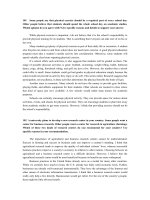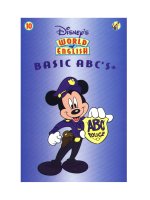Correct english 10 potx
Bạn đang xem bản rút gọn của tài liệu. Xem và tải ngay bản đầy đủ của tài liệu tại đây (75.6 KB, 6 trang )
ceremony (singular) ceremonies (plural)
See
PLURALS (iii).
certain or curtain CERTAIN means sure.
Are you CERTAIN that he apologised?
CURTAINS are window drapes.
Do draw the CURTAINS.
Note that the c sounds like s in certain
and like k in curtain.
See
SOFT C AND SOFT G.
changeable (not -gable)
See
SOFT C AND SOFT G.
chaos chaotic
character (not charachter)
chateau/cha
ˆ
teau chateaux or cha
ˆ
teaux (plural)
(singular) See
FOREIGN PLURALS.
check or cheque? Use these exemplar sentences as a guide:
Always CHECK your work.
May I pay by CHEQUE?(not ‘check’ as in
the United States)
cherub (singular) This word has two plurals.
Cherubim is reserved exclusively for the
angels often portrayed as little children
with wings.
Cherubs can be used either for angels or
for enchanting small children.
chestnut (not chesnut, as it is often mispronounced)
chief (singular) chiefs (plural)
See
PLURALS (v).
childish or childlike? The teenager was rebuked by the
magistrate for his CHILDISH behaviour.
(i.e. which he should have outgrown)
The grandfather has retained his sense of
CHILDLIKE wonder at the beauty of the
CHILDISH OR CHILDLIKE?
37
natural world. (i.e. marvellously direct,
innocent and enthusiastic)
chimney (singular) chimneys (plural)
See
PLURALS (iii).
chior Wrong spelling. See
CHOIR.
chocolate (not choclat although often
mispronounced as such)
choice (not -se)
choir (not -io-)
choose I CHOOSE my words carefully.
IamCHOOSING my words carefully.
I CHOSE my words carefully yesterday.
IhaveCHOSEN them carefully.
chord or cord? CHORD is used in a mathematical or
musical context.
CORD refers to string and is generally
used when referring to anatomical parts
like the umbilical cord, spinal cord and
vocal cords.
Note: you will occasionally see CHORD
used instead of CORD in a medical
context but it seems very old-fashioned
now.
Christianity (not Cr-)
Christmas (not Cristmas or Chrismas)
chronic (not cr-)
This word is often misused. It doesn’t
mean terrible or serious. It means long-
lasting, persistent, when applied to an
illness.
chrysanthemum (not cry-)
chrystal Wrong spelling. See
CRYSTAL.
cieling Wrong spelling. See
CEILING.
cigarette (not -rr)
CHIMNEY
38
cite, sight or site? To CITE means to refer to.
SIGHT is vision or something seen.
A SITE is land, usually set aside for a
particular purpose.
clarity See
AMBIGUITY.
clothes or cloths? CLOTHES are garments.
CLOTHS are dusters or scraps of material.
coarse or course? COARSE means vulgar, rough:
COARSE language, COARSE cloth.
COURSE means certainly:
OF COURSE
COURSE also means a series of lectures, a
direction, a sports area, and part of a
meal:
an advanced COURSE
to change COURSE
agolfCOURSE
the main COURSE
codeine (not -ie-)
colander (not -ar)
collaborate collaborated, collaborating
collaborator collaboration
collapse collapsed, collapsing
collapsible (not -able)
colleagues
collective nouns See
NOUNS.
college (not colledge)
colloquial
collossal Wrong spelling. See
COLOSSAL.
colonel or kernel? A COLONEL is a senior officer.
A KERNEL is the inner part of a nut.
COLONEL OR KERNEL?
39
colons (i) Colons can introduce a list:
Get your ingredients together:
flour, sugar, dried fruit, butter and
milk.
Note that a summing-up word should
always precede the colon (here
‘ingredients’).
(ii) Colons can precede an explanation or
amplification of what has gone before:
The teacher was elated: at last the
pupils were gaining in confidence.
Note that what precedes the colon
must always be able to stand
on its own grammatically. It must be
a sentence in its own right.
(iii) Colons can introduce dialogue in a
play:
Henry (with some embarrassment): It’s
all my own fault.
(iv) Colons can be used instead of a
comma to introduce direct speech:
Henry said, with some embarrassment:
‘It’s all my own fault.’
(v) Colons can introduce quotations:
Donne closes the poem with the
moving tribute:
‘Thy firmness makes my circle just
And makes me end where I began.’
(vi) Colons can introduce examples as in
this reference book.
Compare
SEMICOLONS.
colossal (not -ll-)
colour (not color, as in American English)
COLONS
40
colourful
comemorate Wrong spelling. See
COMMEMORATE.
comfortable (four syllables, not three)
coming come+ing=coming(not comming)
See
ADDING ENDINGS (ii)
comission Wrong spelling. See COMMISSION.
commands (i) Direct commands, if expressed
emphatically, require an exclamation
mark:
Stop, thief!
Put your hands up!
Stop talking!
If expressed calmly and
conversationally, however, a full stop
is sufficient:
Just wait there a moment and I’ll be
with you.
Tell me your story once again.
(ii) Reported commands (indirect
commands) never need an
exclamation mark because, when they
are reported, they become statements.
He ordered the thief to stop.
She told him to put his hands up.
The teacher yelled at the class to
stop talking.
commas Commas are so widely misused that it is
worth discussing their function in some
detail. First, let us make it very clear
when commas cannot be used.
(a) A comma should never divide a
subject from its verb. The two go
together:
My parents, had very strict views.
My parents had very strict views.
COMMAS
41
Take extra care with compound
subjects:
The grandparents, the parents, and
the children, were in some ways to
blame.
The grandparents, the parents, and
the children were in some ways to
blame.
(b) Commas should never be used in an
attempt to string sentences together.
Sentences must be either properly
joined (and commas don’t have this
function) or clearly separated by full
stops, question marks or exclamation
marks.
Commas have certain very specific jobs to
do within a sentence. Let us look at each
in turn:
(i) Commas separate items in a list:
I bought apples, pears, and grapes.
She washed up, made the beds, and
had breakfast.
The novel is funny, touching, and
beautifully written.
The final comma before ‘and’ in a list
is optional. However, use it to avoid
any ambiguity. See (ix) below.
(ii) Commas are used to separate terms of
address from the rest of the sentence:
Sheila, how nice to see you!
Can I help you, madam?
I apologise, ladies and gentlemen, for
this delay.
Note that a pair of commas is needed
in the last example above because the
term of address occurs mid-sentence.
It is a very common error to omit
COMMAS
42









